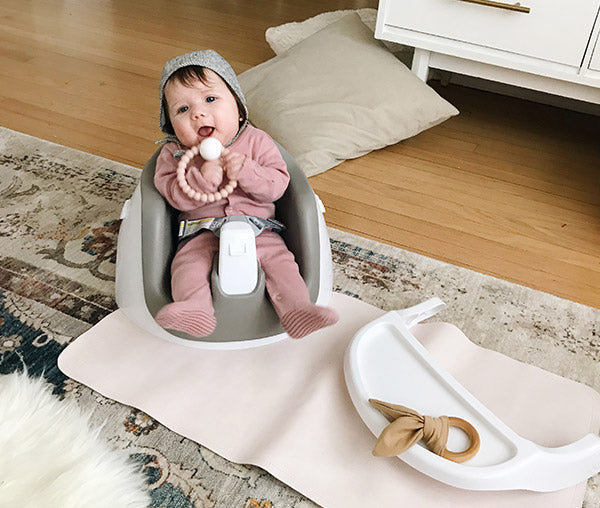
October 30, 2020
Month by Month Guide to Help Your Baby Build Fine Motor Skills
As your little one is working on mastering the BIG elements of movement (their gross motor skills) like walking, running, and jumping—it is equally important to help them develop their fine motor skills too. Establishing their independence, by running down the hall way, needs to be coupled with all the little things they can learn to do with their hands.
Fine motor skills will not only help your toddler to learn to zip their jacket or pick up their crayons, but will help them build the neurological bridges necessary for future learning to take place. Before your child can learn to write their name, they have to first learn how to pick up and hold a crayon. To learn this dexterity, practicing fun games and activities to hone these skills can be part of your daily routine.
But, when and how do you start helping your child develop their fine motor skills? The answer: as soon as possible!
Between 0–6 Months:
At this age, much of baby's fine motor skills are dictated by reflexes only. You can help these reflexes turn into the stepping stones for future fine motor development.
Things you can do at this age:
- Offer baby small objects to hold while you are changing his diaper. Help him curl his fingers around the object.
- Show baby high contrast and brightly colored objects.
- Offer baby lots of eye contact and allow him to see himself in the mirror.
- Rub the middle of his palms and bottoms of his feet to encourage reflex reactions.
- Work on tummy time, building up these muscles will help baby to have the strength to practice fine motor skills in the later months.
The website whattoexpect.com offers some more ideas about what you can do to help baby at this age develop the skills he will need as he gets bigger and stronger.
From 6–12 months:
 IG: @pececindy
IG: @pececindy
Baby is probably ready to work on some true fine motor skills at this point because they will have more control of their head, arms and legs. Now that baby is stronger you'll start noticing him learning the pincer grasp (using only his thumb and forefinger to pick things up) and also transferring toys from hand to hand.
You can try:
- Offering baby two toys at a time, and encourage reaching with both hands.
- Teach baby how to splash in the tub with one hand, two hands, or by dropping their bath toys. (Have a towel handy! This one becomes really fun! Read: WET)
- Let baby turn the pages of the book you're reading at bedtime, even if you haven't read all the way to the bottom of the page yet.
- Blocks and other stacking toys, although baby will be better at knocking them down.
- Try letting baby get the light switch when you enter or exit a room.
- Embrace the mess. Babies of this age love to dump things out of their containers. Luckily this is a great skill building activity. Letting them dump things out and also put them back in will help with their grasping skills. Check out this fun DIY ball sorting activity using an old anti-bacterial wipes container
According to Kid Central, between 12–15 months your baby should be able to:
- Point at things with only one finger
- Pick up tiny objects using only thumb and forefinger
- Hold something out for you to take, or pull it away from you when you try to take it.
- Walk with one or both hands held, or walk alone without support
- Rock to the rhythm while standing alone, bounce or react to music
- Stoop to pick up things on the floor
 IG: @bahartak
IG: @bahartak
Some great activities to work on these skills are threading games. These games encourage both the mastery of the pincer grasp, but also a child's creativity.
Macaroni Necklaces: These are great to make because they can be colorful and creative, working on pattern making and color identifying. They also encourage that delicate pincer grasp and hand-eye coordination to thread the macaroni onto the string.

GIANT Beads: Pool Noodle Stringing! Simply by cutting up a normal pool noodle, you can create a great learning toy for your toddler. Pieces of noodle become giant beads which can be strung onto a length of rope.

Pipe Cleaner threading with basic kitchen tools: An everyday kitchen colander becomes a great toy when paired with a handful of pipe cleaners. Show baby how sticking the pipe cleaners through the holes allows them to stand up, and then let baby thread them through the holes!

Remember to have patience and play with the baby. Every day is a new learning opportunity and with a little imagination, you can create a learning toy out of just about anything. These skills will build gradually as your child ages, just keep practicing and allowing their cognitive and gross development to lead the way for fine motor skills.